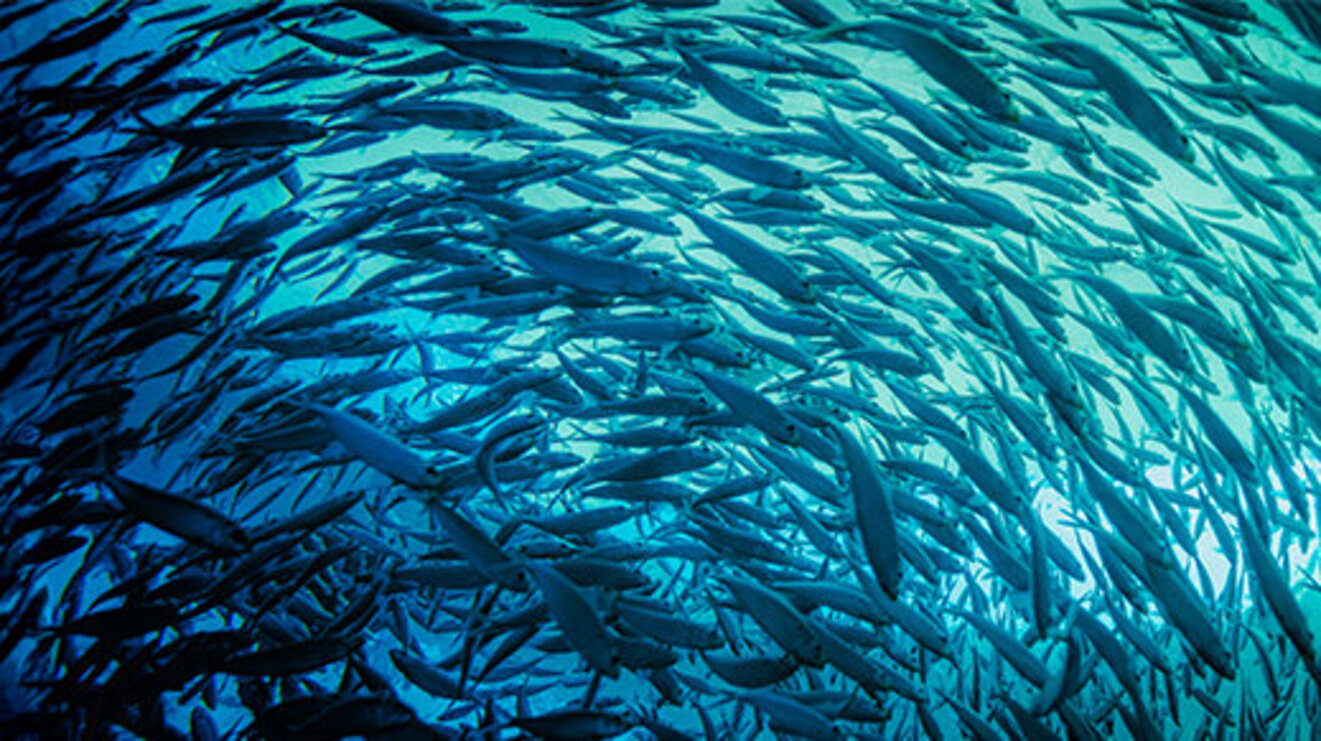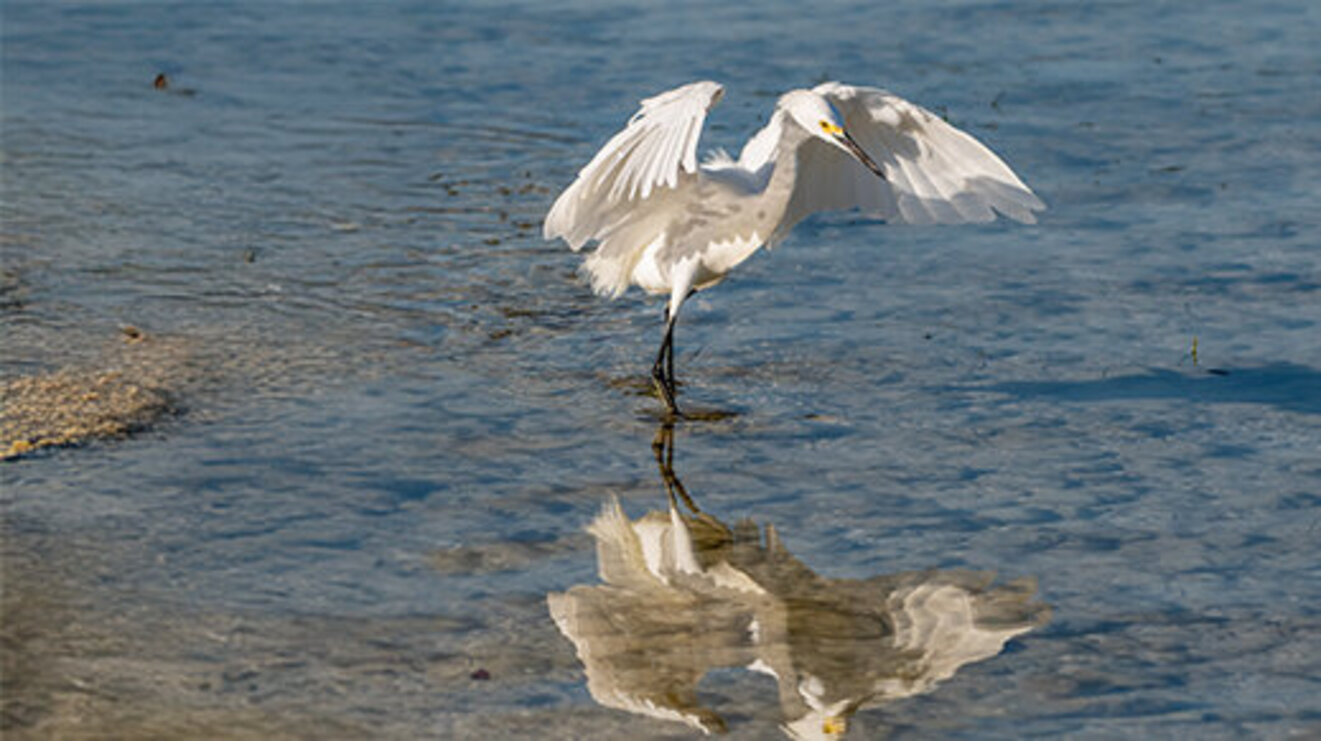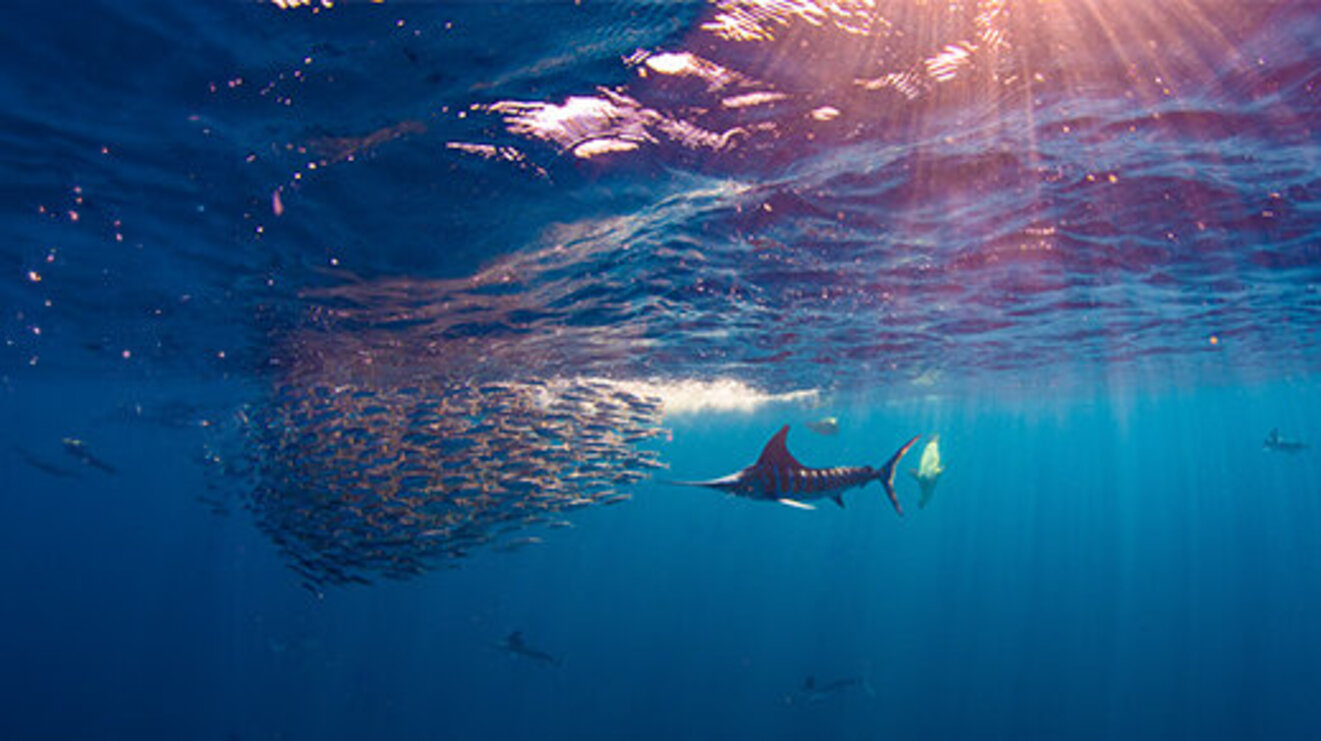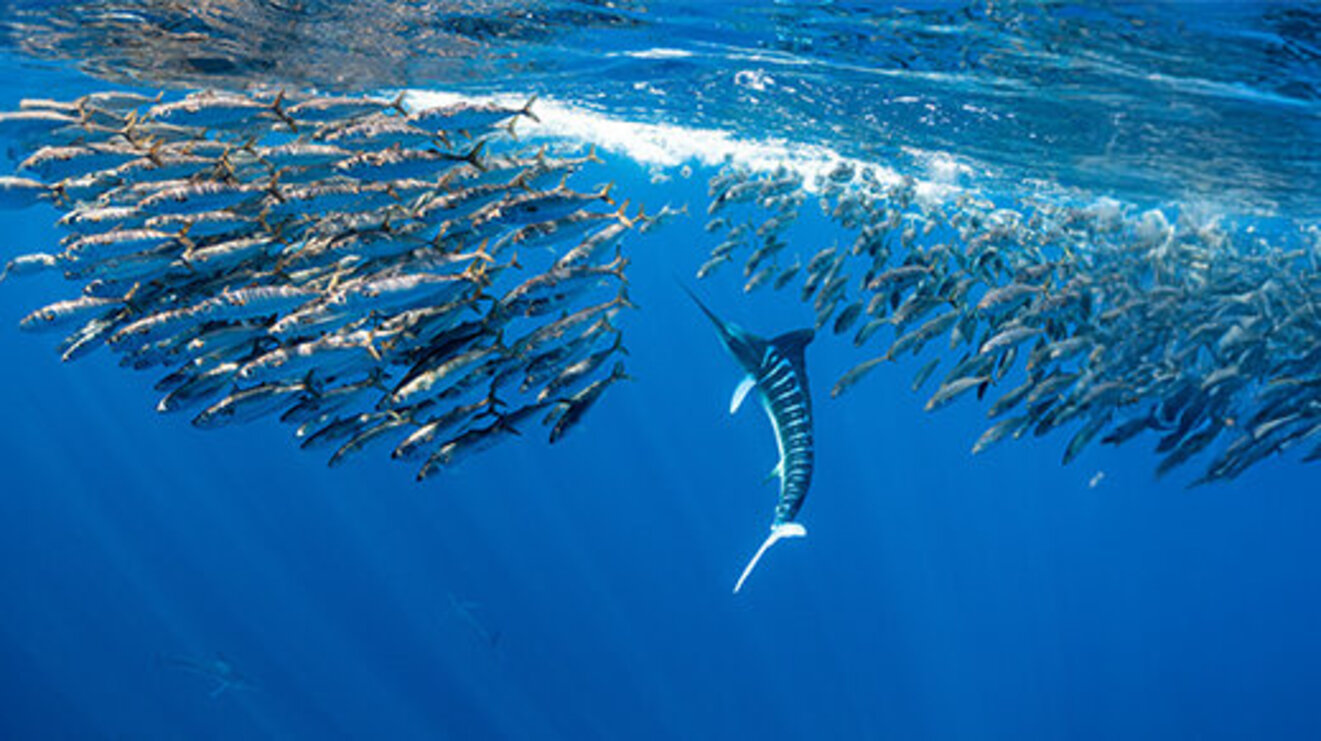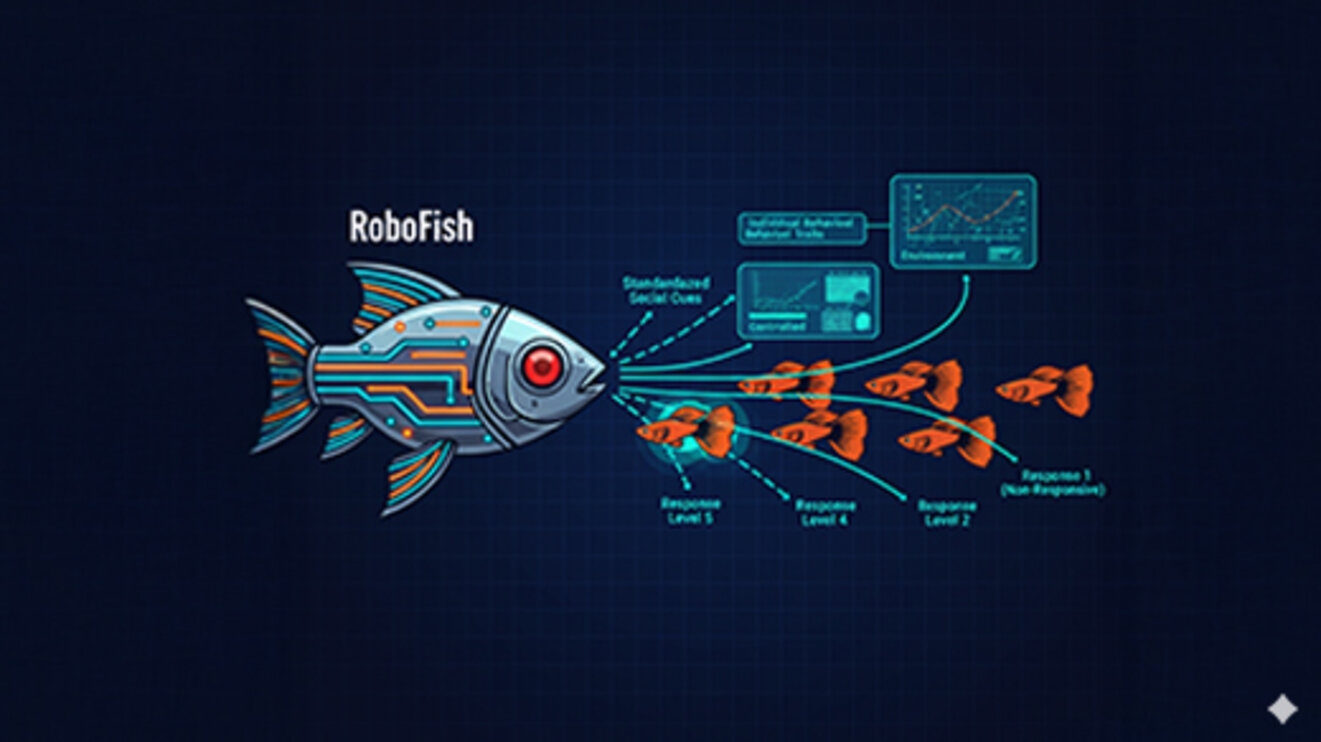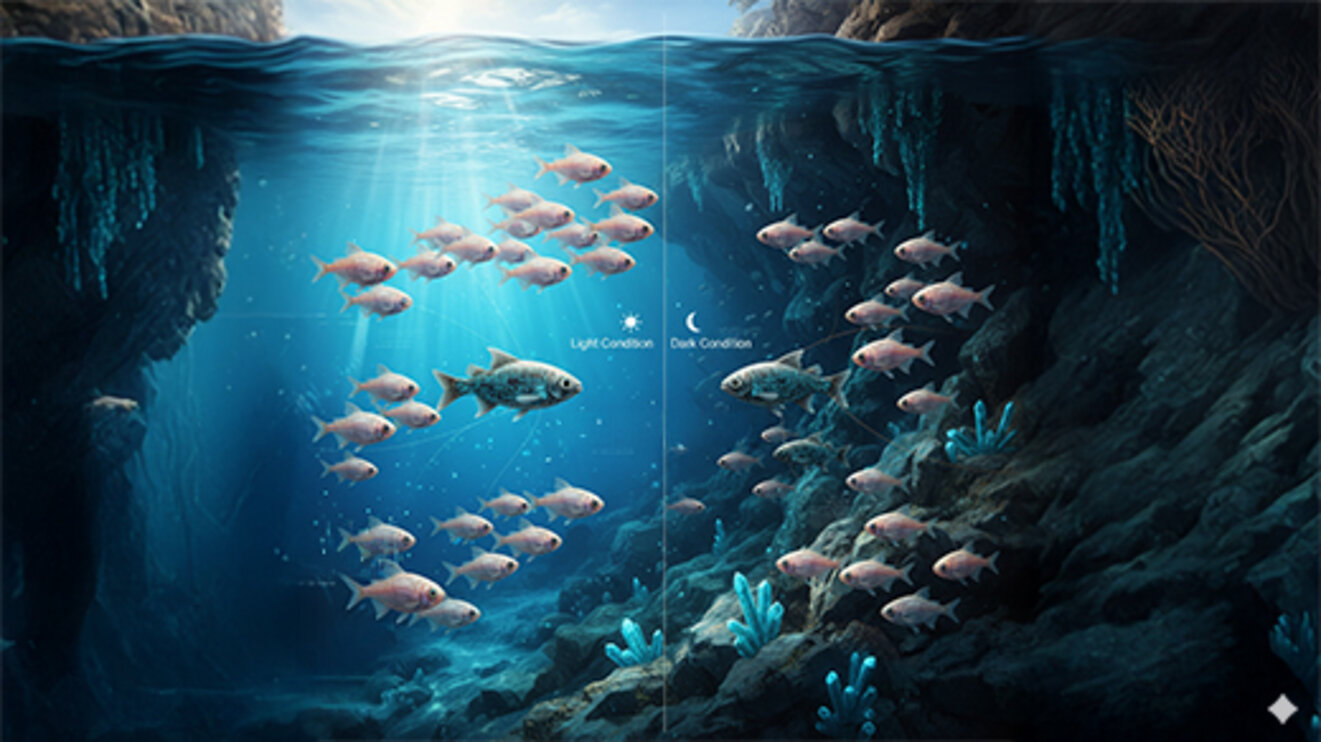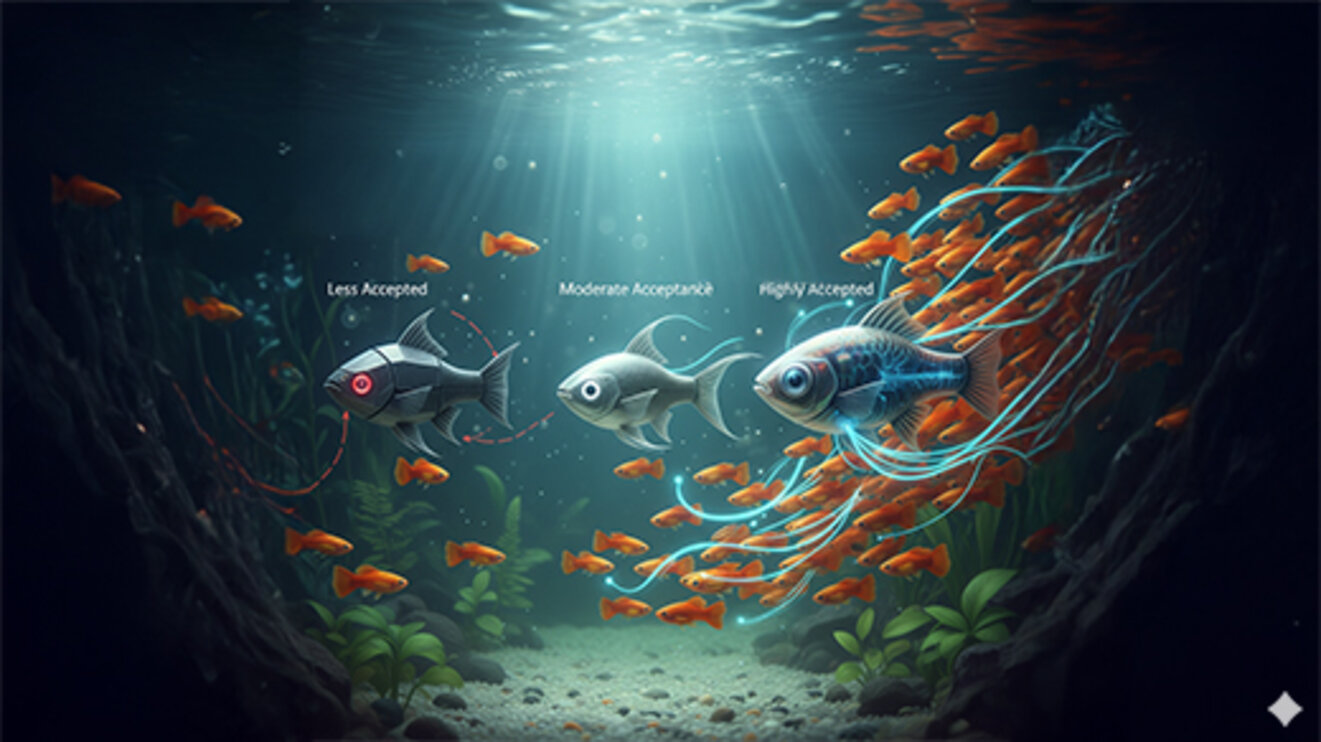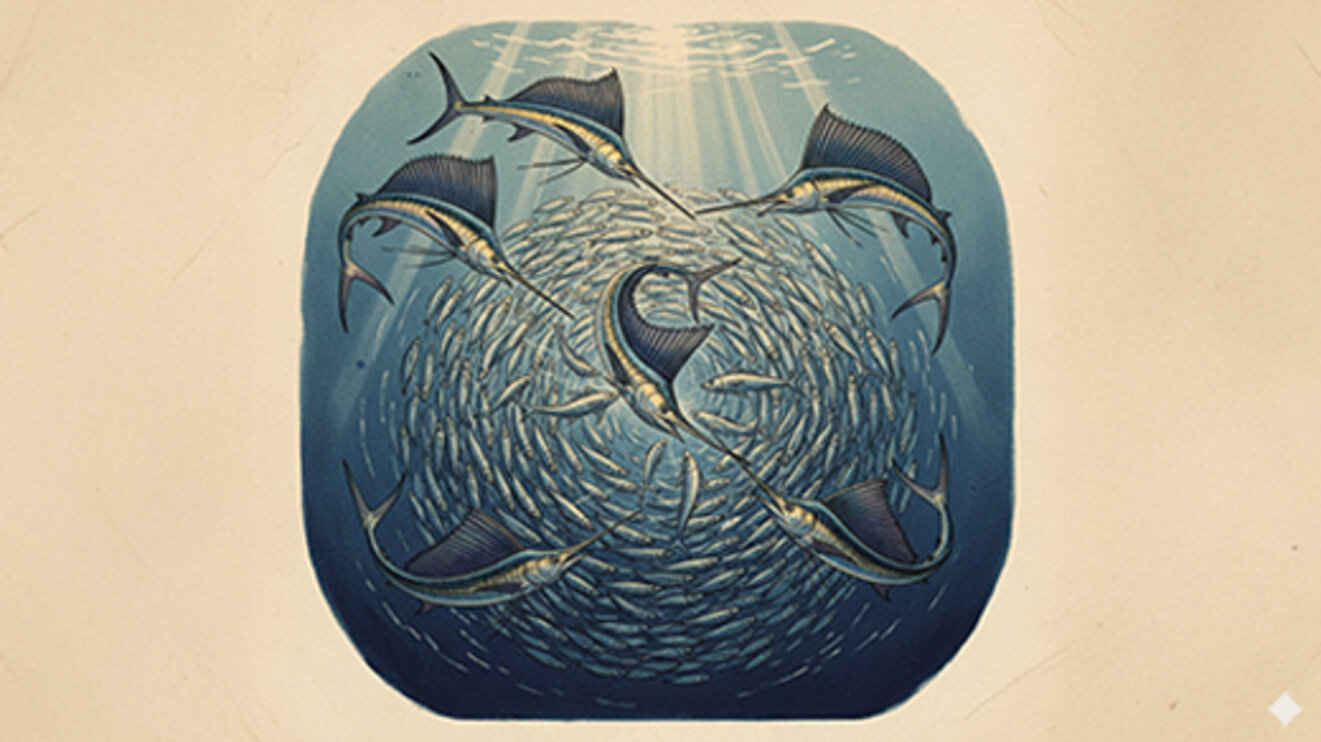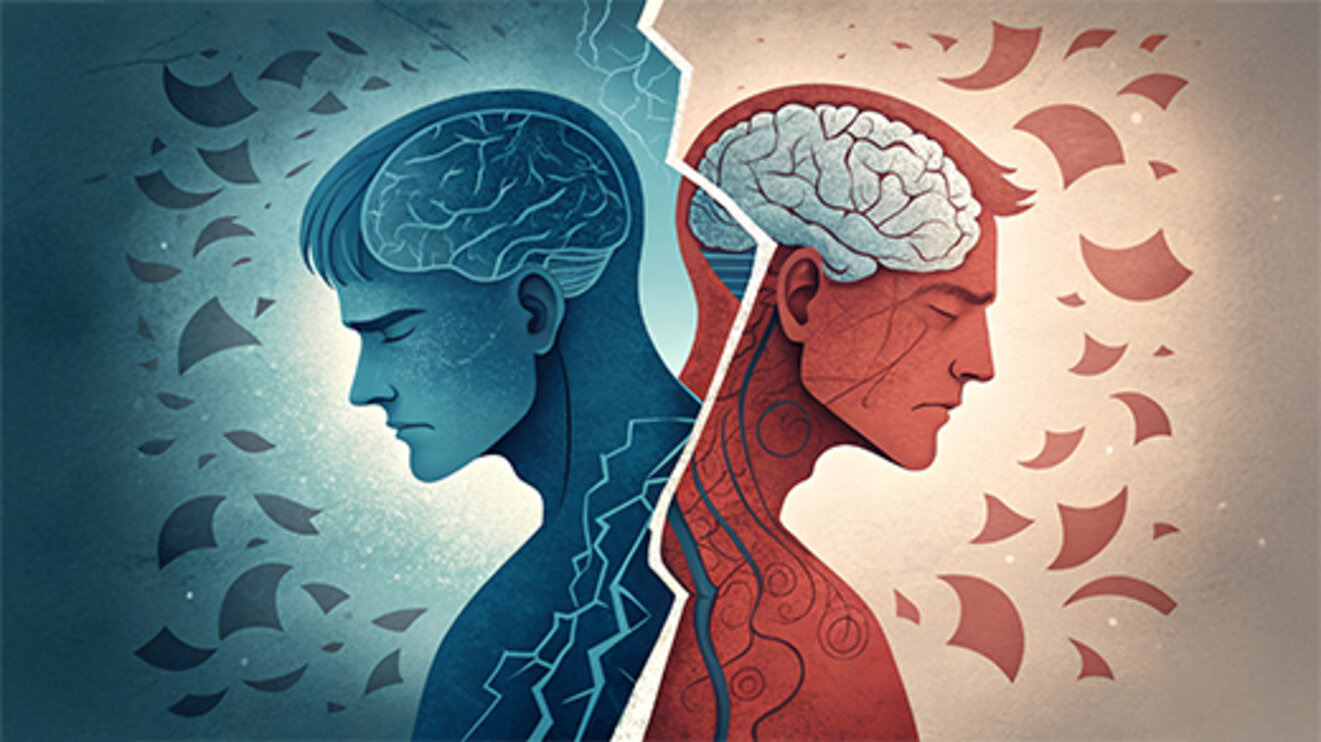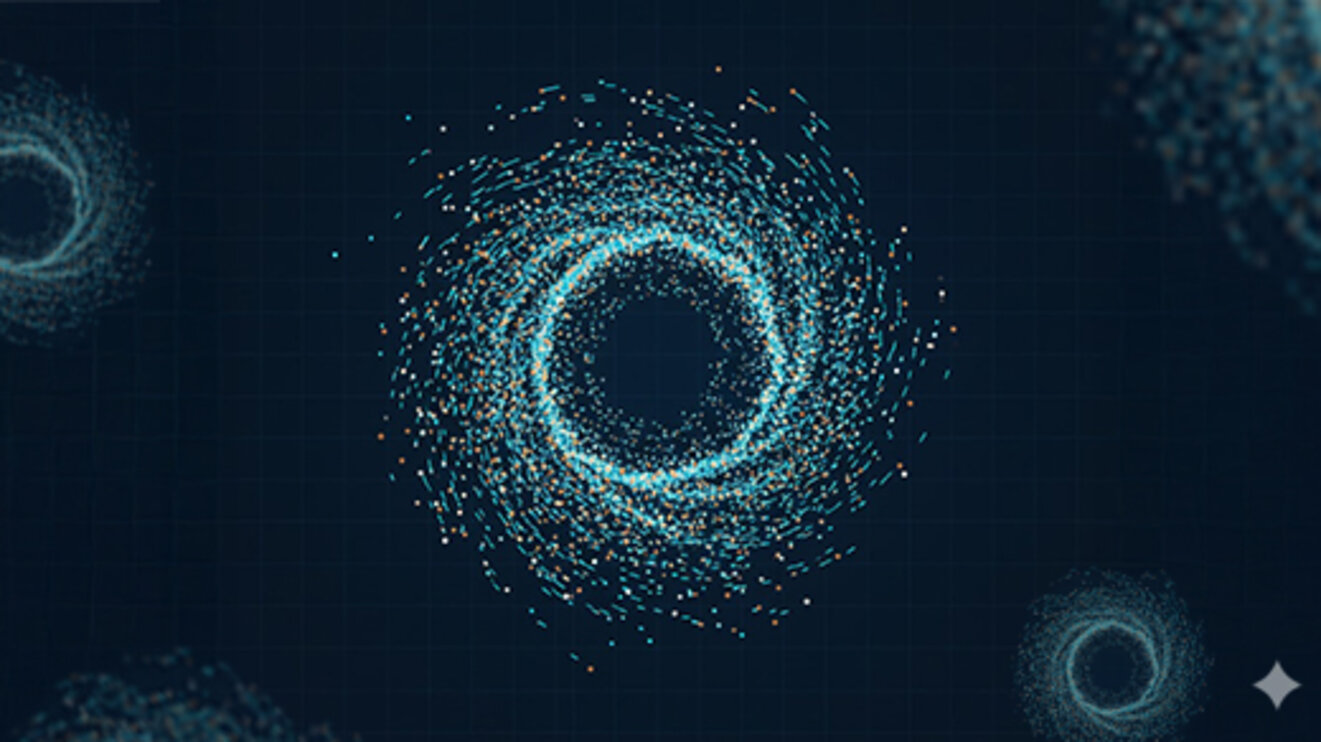Interdisciplinary publications
Biology & Horticultural and Agricultural Sciences
Better and faster decisions by larger fish shoals in the wild
When danger looms, there’s safety in numbers - but do big groups also panic more easily? In the wild, animals often make life-or-death decisions together, yet it hasn’t been clear whether larger groups are better at spotting real threats without overreacting to harmless ones. The Collective Information Processing Group (Pawel Romanczuk) & the Mechanisms and Functions of Group-Living Group(Jens Kause) examined the behaviour of fish shoals and found that bigger groups aren’t just faster at detecting predators, they’re also no more likely to fall for false alarms. In fact, larger shoals make decisions both quicker and more accurately, avoiding the usual trade-offs that solitary individuals face. These findings highlight how collective intelligence can sharpen survival strategies in nature. Find out more in their Science Advances Article!
Collective escape waves provide a generic defence against different avian predators
Collective behaviors in animals are often governed by simple interaction rules and raise a fundamental question: does this mechanistic simplicity translate to functional generality? Specifically, if collective behavior provides anti-predator benefits, does it offer consistent protection against diverse predators? The Collective Information Processing Group (Pawel Romanczuk) & the Mechanisms and Functions of Group-Living Group(Jens Kause) examined this question in sulphur-adapted fish populations in Mexico, where schools face predation from various bird species and respond with synchronized 'escape waves.' By observing natural interactions, they found that all bird species delayed attacks in response to increasing wave frequency, both before and after initiating predation. While post-attack wave responses were similar across bird species, pre-attack wave patterns varied, likely due to differences in perceived threat. Simulated bird arrivals confirmed this, revealing that predator size and visibility influence fish perception. This suggests that the fish's generalized collective response and its consistent impact on diverse predators stem from the waves exploiting a common weakness in visual processing, shared across different predators. Find out more in their Royal Society Open Science Article!
Evidence for a by-product mutualism in a group hunter depends on prey movement state
Group hunting is a widespread strategy among various animal species, offering potential benefits such as increased hunting success and reduced individual risk. Understanding the complex interactions between predators and prey is crucial for comprehending the evolution of cooperation and social behavior. Prey movement plays a pivotal role in predator-prey dynamics. Prey often respond to predation threats by either fleeing or standing their ground, significantly influencing the costs and benefits of predator and prey strategies. The Collective Information Processing Group (Pawel Romanczuk) & the Mechanisms and Functions of Group-Living Group(Jens Kause) investigated how prey behavior affects predator strategies of striped marlin, Kajikia audax and the overall dynamics of their predator-prey interactions. Check out their Functional Ecology Article!
Sailfish generate foraging opportunities for seabirds in multi-species predator aggregations
While some predators compete with each other for prey, others benefit from the other, intentionally or unintentionally. Seabirds, for example, profit immensely from the presence of subsurface predators and therefore often share a habitat. However, the principle behind this phenomenon is poorly understood. The Collective Information Processing Group (Pawel Romanczuk) & the Mechanisms and Functions of Group-Living Group(Jens Kause) performed spatio-temporal analysis of drone footage to unravel the hunting behaviour of Indo-Pacific sailfish and terns and made some interesting discoveries. Find out more in their Biology Letters Aritcle!
Collective anti-predator escape manoeuvres through optimal attack and avoidance strategies
When predators strike, chaos becomes coordination. The Collective Information Processing Group (Pawel Romanczuk) & the Mechanisms and Functions of Group-Living Group(Jens Kause) combined drone observations of sardine schools (Sardinops sagax caerulea) attacked by striped marlin (Kajikia audax) with agent-based modeling to uncover the origins of the spectacular fountain effect—the collective, upward-splashing motion of prey as they evade predators. Their analyses reveal that this escape pattern arises naturally from simple social and individual rules designed to maximize each fish’s survival. Prey that adjust their escape angle to increase distance from the predator, while also responding to nearby neighbors, generate the same collective fountain patterns seen in the wild. By linking predator attack strategies with prey decision-making, they show that these dramatic displays are not random but emergent outcomes of adaptive behavior—where the physics of movement meets the logic of survival. Check out their communications biology Article!
Multispecies collective waving behaviour in fish
Acting together can save lives - but what happens when not everyone plays along? In this study, we investigated mixed-species fish shoals of Poecilia sulphuraria (sulphur mollies) and Gambusia eurystoma (widemouth gambusia), which perform collective dives that generate surface waves deterring attacking birds. While mollies almost always dove after a simulated attack, gambusia were far less responsive. When the two species formed mixed groups, mollies reduced their diving depth, suggesting that less responsive neighbors can dampen the collective defense. Interestingly, gambusia behavior remained unchanged by the presence of mollies. These results reveal that variation within and between species shapes how effectively groups can coordinate under threat - offering new insight into the evolution and mechanics of collective behavior in complex, multi-species systems.
Live fish learn to anticipate the movement of a fish-like robot
Anticipation - the ability to predict what others will do and adjust one’s own behavior - is a cornerstone of complex social interaction. While well studied in mammals, much less is known about this ability in fish. Pawel Romanczuk & Jens Krause used a biomimetic robotic fish (RoboFish) to test whether live guppies (Poecilia reticulata) can anticipate the predictable movements of a social partner. The robot repeatedly followed the same zigzag path toward a fixed corner, allowing the live fish to learn and adjust across trials. Over time, the guppies began arriving at the destination before the robot and even started turning in anticipationof its movements - clear signs of learned prediction. These results show that fish are capable of anticipating both the destination and dynamics of a partner’s movement, suggesting that anticipation may be an important mechanism in coordinating social behavior even in relatively simple organisms.
Fish waves as emergent collective antipredator behavior
In the wild, coordinated movement can be more than beautiful — it can be life-saving. Pawel Romanczuk & Jens Krause revealed the anti-predator function of “fish waves”, the striking, rhythmic surface patterns produced when thousands of fish dive simultaneously in response to attacking birds. Through field observations and controlled experiments, they found that these waves caused birds to delay their next attack and even reduced their capture success. Predators often switched perches after repeated waves, suggesting that the display disrupted their hunting rhythm or signaled that the prey were alert. These results show that collective behavior can serve as an active defense strategy, where synchronized movement not only confuses predators but also communicates awareness — turning a school of fish into a coordinated, dynamic shield.
Collective rule-breaking
Rules guide much of our daily life - yet people often break them, especially when others do too. Pawel Romanczuk & Jens Krause explored how social influence drives rule-breaking, from individual decisions to large-scale collective behavior. By connecting insights from cognitive psychology, microsociology, and mathematical modeling, they uncover how social contagion can spread acts of defiance, sometimes in a nonlinear, rapidly escalating way. Understanding these dynamics can help explain why rule-breaking often emerges suddenly and spreads unpredictably through groups or crowds. This interdisciplinary perspective aims to lay the groundwork for a predictive science of collective rule-breaking, revealing how the same principles that shape coordination and cooperation can also fuel social disruption.
Acoustic and visual stimuli combined promote stronger responses to aerial predation in fish
When danger strikes from above, reaction speed can mean survival. Pawel Romanczuk & Jens Krause explored how the sulphur molly (Poecilia sulphuraria) - a small freshwater fish living under constant threat from diving birds - uses sensory cues to anticipate attacks. Through field observations and controlled experiments, they tested how these fish respond to visual and acoustic cues that mimic bird disturbances. The results show that mollies react to almost any cue by diving, but adjust their depth, speed, and duration based on the type and combination of signals. When both visual and sound cues are present, responses become stronger and more sustained - revealing that fish can integrate multimodal information to fine-tune their antipredator behavior. In a world where danger is constant, this strategy - respond first, refine later - helps these fish balance survival with the need to conserve energy for the next attack.
Group-level patterns emerge from individual speed as revealed by an extremely social robotic fish
What makes animal groups move together — and what gives rise to leaders and followers? Pawel Romanczuk & Jens Krause uncover how individual speed shapes collective behaviour. Using an innovative setup where live guppies interacted with a biomimetic robotic fish that mirrored their movements in real time, they were able to disentangle the effects of speed from social influence. The results reveal that faster individuals tend to lead more, form looser groups, and achieve better coordination — showing that speed is a key driver of collective dynamics. By combining behavioural experiments, individual-based modelling, and robotics, their work bridges biology and physics to illuminate how simple traits at the individual level can scale up to the complex patterns seen in animal groups.
An interaction mechanism for the maintenance of fission-fusion dynamics under different individual densities
Social life in animals often remains surprisingly stable, even as the world around them changes. Pawel Romanczuk & Jens Krause explored how Atlantic mollies (Poecilia mexicana) maintain their patterns of association — known as fission-fusion dynamics — across different environments and population densities. Comparing surface-dwelling mollies that face high bird predation with their cave-dwelling relatives that live in low-predation, sulfidic waters, they found that surface fish spend more time together and are more likely to stay with or return to social partners. Remarkably, they maintain these social dynamics even when density decreases — something cave mollies do not achieve. By analyzing movement patterns and modeling spatial arrangements, they show that surface mollies compensate for lower density by reducing the area they collectively occupy, allowing them to preserve social cohesion while still exploring their environment. This flexibility highlights how movement rules and spatial coordination can stabilize social structures under ecological pressure.
Guppies Prefer to Follow Large (Robot) Leaders Irrespective of Own Size
What makes an effective leader - behavior or body size? Pawel Romanczuk & Jens Krause used biomimetic robotic fish (RoboFish) to uncover how size influences leadership in guppies (Poecilia reticulata). By standardizing the robot’s behavior, they could isolate the effect of size itself, revealing the subtle cues that shape social following. Live female guppies consistently followed larger RoboFish leaders more closely than smaller ones, regardless of their own size or boldness. This demonstrates that body size alone can enhance leadership, independent of behavioral differences or personality traits. Their findings highlight how physical traits can drive social organization — and how robotic models provide powerful tools for disentangling the complex links between appearance, behavior, and influence in animal groups.
Using a robotic fish to investigate individual differences in social responsiveness in the guppy
Responding to the actions of others is a key aspect of social behavior, but mutual influences can make it hard to study individual differences. Pawel Romanczuk & Jens Krause used a biomimetic open-loop robot (RoboFish) to investigate how live guppies (Poecilia reticulata) respond to standardized social cues. While responses to RoboFish were slightly weaker than to live companions, individual guppies maintained consistent differences in responsiveness across both robot and live interactions — and these differences persisted over multiple trials. These findings highlight that biomimetic robots are powerful tools for disentangling social interactions and measuring individual behavioral traits, providing a controlled window into the dynamics of social responsiveness in fish.
Insights into the Social Behavior of Surface and Cave-Dwelling Fish (Poecilia mexicana) in Light and Darkness through the Use of a Biomimetic Robot
How do animals recognize and respond to others in their environment - and what happens when their senses change? Pawel Romanczuk & Jens Krause used their biomimetic RoboFish to explore how surface- and cave-dwelling mollies differ in their social responses. These two populations of Poecilia mexicana vary in their sensory adaptations: while surface fish live in light-rich habitats, cave mollies have evolved in near darkness with reduced pigmentation and smaller eyes. By pairing both types of fish with live companions and RoboFish under light and dark conditions, they found that visual cues are key. Both populations followed RoboFish and live partners in light, but in darkness, only surface fish were attracted to live conspecifics - and neither group responded to the robot. These results reveal that their RoboFish is primarily perceived through vision and highlight how sensory evolution shapes social behavior.
RoboFish: increased acceptance of interactive robotic fish with realistic eyes and natural motion patterns by live Trinidadian guppies
How do you make a robot feel “real” to a fish? Understanding animal social behavior with robotic partners depends on one crucial factor - acceptance. Pawel Romanczuk & Jens Krause explored how live Trinidadian guppies respond to our biomimetic RoboFish, revealing what makes artificial agents blend naturally into animal groups. By testing different designs, motion patterns, and interaction modes, they found that realistic eye dummies and natural swimming movements dramatically increase acceptance. Their interactive RoboFish can even imitate individual behavioral traits of live animals, expanding its potential for behavioral studies. These advances bring us closer to using robotic systems as powerful, flexible tools for uncovering the rules of social interaction in animals.
Proto-cooperation: group hunting sailfish improve hunting success by alternating attacks on grouping prey
How do predators hunt together without coordinating their moves? Pawel Romanczuk & Jens Krause revealed a novel form of group hunting in sailfish (Istiophorus platypterus) preying on schooling sardines (Sardinella aurita). Individual sailfish take turns attacking, each strike injuring multiple prey even when few are captured. As the number of injured fish grows, so does the success rate of the hunters - showing that each attack benefits the group as a whole. By combining field observations with a mathematical model of hunting dynamics, they show that these alternating attacks yield major efficiency gains for groups of up to 70 individuals. Their model also uncovers when “free riders” - individuals that wait to attack until prey are weakened - can benefit, depending on the costs of striking. These findings provide rare evidence for cooperative benefits without coordination, a kind of “proto-cooperation” that may represent an evolutionary step toward more complex collective hunting strategies.
Psychology & Horticultural and Agricultural Sciences
Only reappraisers profit from reappraisal instructions: Effects of instructed and habitual reappraisal on stress responses during interpersonal conflicts
Conflicts are stressful - but can changing how we think about them make them easier to handle? Ursula Hess & Grudrun Brockmann tested whether people could buffer stress during an interpersonal conflict by using emotion regulation strategies like reappraisal (seeing the situation in a new light) or suppression (hiding emotional reactions). While participants fought their way through a standardized lab argument, researchers tracked stress responses through heart rate, cortisol levels, and even snack-eating behavior. The results revealed that reappraisal helped only those who already tended to use it in daily life: habitual reappraisers stayed calmer, had lower physiological stress, and snacked less. For those who rarely reappraise, the same instruction actually increased stress. The takeaway? The right emotion strategy depends on the person - what soothes one individual might stress another.
Biology & Physics
Active Brownian Particles - From Individual to Collective Stochastic Dynamics
How do self-propelled entities - from chemical nano-rods and motile cells to animals in motion - move, interact, and form patterns? In this study, Pawel Romanczuk & Benjamin Lindner dive into the theoretical foundations of active matter, combining nonlinear and stochastic models to understand how simple rules of motion give rise to complex collective dynamics. Using tools from statistical mechanics, they explore how fluctuations, velocity-dependent friction, and different interaction types shape motion - from single active particles to large assemblies. The result is a detailed picture of how individual randomness transforms into organized behavior, revealing the physical principles behind swarming, clustering, and pattern formation across scales.
